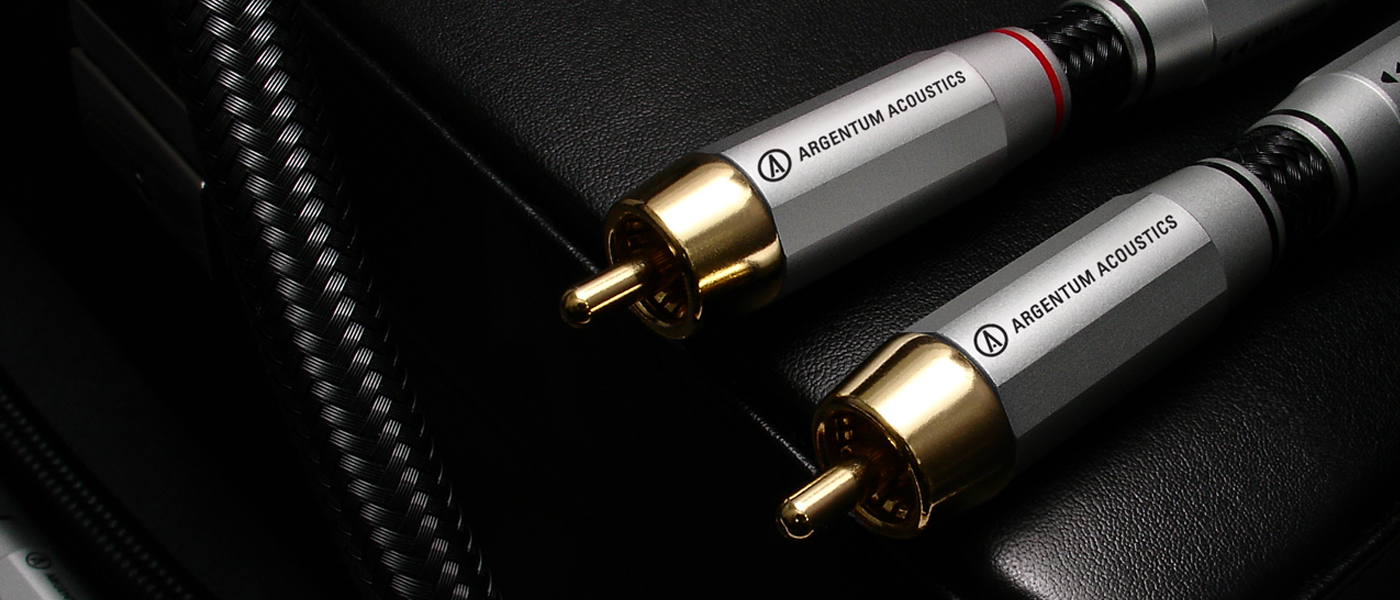Introduction
While at the CEDIA show last September, I got the chance to meet David Salz, founder of Wireworld. As a professional scientist who does electrical engineering-related work for a living, I am typically skeptical of the claims of cable manufacturers. Not that I believe all cables sound the same, mind you. I just have issues with the claims that many manufacturers make as to why their cables sound different/better than others. David’s company, and David himself do not fall into this category. They use real, well-accepted engineering principles to design and build their cables.
The Design
The basic principle behind Wireworld’s cable design is the Heaviside condition, named after Oliver Heaviside, a 19th century physicist. Audio cables have very low resistance, and the + and – conductors are well insulated from each other. The Heaviside condition then demands that that both the capacitance and inductance of the cable should be kept as low as possible, but the capacitance and inductance have to be reduced together. When the Heaviside condition is met through balancing the capacitance and inductance of the cable, the electrical impedance of the cable matches the load impedance (i.e. the speaker). Time domain smearing and frequency dependent loss are eliminated.
Specifications
- Eclipse 52 Interconnects: OCC copper Conductors, Teflon Dielectric, Silver Clad OFC Plug Contact, MSRP: $449.95 1m pair
- Silver Eclipse 52 Interconnects: OCC Silver Clad Copper Conductors, Teflon Dielectric, Silver Clad OFC Plug Contact, MSRP: $699.95/1m pair
- Eclipse 52 Speaker Cables: OCC Copper Conductor, 10 AWG/4.6 mm2, high-density polyethylene dielectric, silver clad OFC contacts, MSRP: $1149.95/2.5m pair
- Silver Eclipse 52 Loudspeaker cable: Silver clad OCC copper conductor, 10 AWG/4.6 mm2, high-density polyethylene dielectric, silver clad OFC contacts, MSRP: $2149.95/2.5m pair
- Silver Electra 52 AC power cord: Silver clad OCC copper conductor, 12 AWG/3mm2, Composite insulation, Silver clad copper alloy contacts, MSRP: $699.95/2m
- Wireworld Cable
Wireworld’s cables are designed to be matched as well as possible to low output (for interconnect) and load (for speaker) impedances seen in audio gear, changing the impedance of the connection as little as possible. In addition, Wireworld then does cable bypass testing with both single blind and double blind listening, in addition to traditional listening. In these tests, a junction box allows listeners to compare the sound of a system with a cable in the signal path to the sound of no cable at all. Using this combination of cable design, measurement, and testing, Wireworld tries to make cables that sound as close as possible to no cable at all.
Shown below are the Eclipse 52 interconnect and speaker cables.



Wireworld provided me with a full complement of cables for my system, with front and center speaker cables, interconnects for both two-channel audio and multi-channel signals, and four power cables. Silver-clad copper Silver Eclipse cables were used for all the two-channel interconnects and the full range stereo speaker cables. Less expensive all-copper Eclipse cables were used for the center channel and the second voice coil on my Gallo Reference 3.1s, and for SSP and second voice coil amplifier interconnects. Both types of cables use super high purity Ohno OCC single crystal copper conductors. The silver clad cables add high purity silver cladding on top of an OCC copper core. Interconnects use Teflon dielectric, while the speaker cables use high-density polyethylene dielectric. Connectors are silver clad oxygen free copper. These are the highest quality materials available for cable construction, short of solid silver conductors. Wireworld makes solid silver conductor cable (Gold Eclipse), but I considered this gilding the lily when I made the request to Wireworld for the review cables. The cable compliment they sent me already had a suggested retail price in excess of $12,000.


The unique engineering of Wireworld cables is in the conductor geometry, which can be found in most of their cables. The various cable grades mainly differ in the type and amount of conductor used for speaker cables: oxygen free copper (OFC, 99.99% pure), Ohno OCC single crystal copper (99.9999% pure), silver clad OCC copper or OCC solid silver (99.9999% pure), and 10 or 12 gauge effective wire size. Interconnects vary by type of conductor material and type of insulation (HDPE or Teflon).
Wireworld tunes the capacitance and inductance of their cable using their proprietary cable geometries, which can be seen in the photos below.
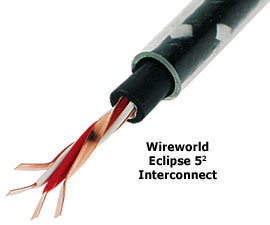
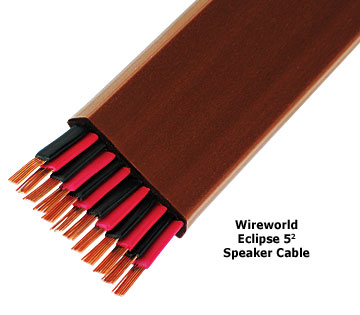
The power cables are particularly interesting. The geometry was chosen to act as a low pass filter, preventing the conduction of high frequency EMI through the cable. These are also available in a variety of conductor materials.
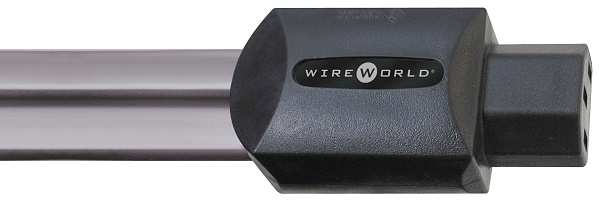
For those who lack the coin to spring for $12k worth of cables for their system (like me), I predict much of the benefits I found with these cables could be had with less expensive Wireworld products with the same geometry as the cables reviewed here. However, keep in mind that only the top five interconnect models, and top six speaker cable models offer the carefully engineered geometry of the cables reviewed here.
Build quality of these cables is top notch, as it should be for the asking price. The speaker cable is reasonably stiff, but actually more flexible than you’d think, given its size. The cable is flexible in one axis only, as is expected with a flat cable. The spade terminations are very beefy. For connection to small, cheesy binding posts like those on my three-channel amp that does center and rear surround duty, the big spades can be an issue. I had to take care to avoid the spades shorting to each other. For good binding posts as found on my speakers and Emotiva stereo amp, the big spades worked very well.
The interconnects have well made RCA connectors, machined out of solid copper, and then gold and silver plated. The interconnects were all clad with a clear flexible plastic jacket that shows off their outer braid, while protecting them. The interconnects are extremely flexible, while still feeling very sturdy. The only negative to the cladding was that the interconnects tended to bind up on each other or other cables while trying to fish them around the back of the rack. The flat conductor AC power cables are also very flexible, with molded on IEC jacks and AC plugs that also use high quality silver-plated copper contacts.
The Sound
Whatever the theory predicts or measurements show, the rubber meets the road at the ear (and brain) of the listener. So, the first thing I did was to listen to my audio gear, not measure it, and I will present my subjective reactions to these cables first.
Cables usually offer subtle improvements on the system sound. This was mostly true with the Wireworld cables, except in two specific areas. The first was in overall noise level. With my previous cables (a combination of Nordost and Kimber products) there was a persistent, low-level ground loop hum and hiss. While this was only clearly audible right up at the speakers, that hum and hiss was obviously lowering the signal to noise of the music. After re-cabling with the Wireworld cables, the 60 Hz hum was eliminated. Even with the preamp gain turned way up, there was no audible hum, even with my ear right on the speaker. The hiss (noise from the preamp and amplifier electronics) was still present, but reduced considerably. This alone was a very big improvement in signal to noise. This improved the “blackness” of the audio background considerably, resulting in a far greater ability to hear small details in the music. This improvement helped both for the timbral and spatial presentation of the music. Images were more focused and better separated, while small differences in tonal shading were preserved more accurately. All of this just because noise was reduced.
Another place where cable can have a more significant effect is in bass impact and weight. A woofer can draw very high instantaneous current from an amplifer during a transient (i.e. a bass drum hit). If a speaker cable’s resistance is not very low, the cable can cause current limiting that “rounds off” the transient. The Wireworld cable’s much larger effective wire gauge and very low resistance as compared to my previous speaker cable resulted in a very noticeable improvement in bass impact and weight. This improvement had the side effect of making the bass seem more extended, although I doubt this was a real frequency response effect.
Improvements in other areas of performance were subtler. Remember, good cable is icing on the cake, and will not make up for poor system performance. The reactance induced by speaker cables changes the frequency response of the speaker they’re used with. As the measurements section will show, these cables have almost an order of magnitude less reactance than my usual speaker cable. The much smaller high frequency inductance should result in less roll-off at the top end. I did notice a bit more sparkle up top, and some badly made recordings annoyed me a bit more than usual. With well-done recordings, the high frequency extension was very welcome. If you have a really bright system already, then maybe some cables with more inductance might be better. For systems that are balanced well, these Wireworld cables are just the ticket.
I did not try to isolate which cables made the most improvement, or if the speaker, interconnect or AC cords were specifically responsible for any improvements. Taken as a full system, I could not be happier with these cables. It’s not like I had low quality cables before. The MSRP on my normal cables is well over $2000. Substituting these Wireworld cables made a very noticeable improvement that I will be sad to see go. I would love to have them in my system permanently as my reference cables.
On the Bench
I used my Smith and Larson Audio Woofer Tester 2 impedance analyzer to measure the impedance of both the speaker cables and the interconnects. This test is most applicable to speaker cables. The interconnects drive very high impedance loads with very small currents, and are therefore much less effected by cable impedance. I tested the interconnects anyway. I did not have the necessary equipment to measure frequency response, time domain response, or noise pickup, and was therefore not able to measure the filtering properties of the AC power cords.
For the tests I did do, I made some 10 Ohm loads for the speakers and interconnects. The speaker load is a five-way binding post with a 2% 10 Ohm resistor across the terminals. The interconnect load is an RCA jack with another 10 Ohm resistor across the terminals. The Smith and Larson woofer tester is designed to measure low impedances, so I could not use a high resistance load resistor to test the interconnect. In each case, I calibrated the impedance analyzer with the same loads used to measure the cable. This removes the impedance of both the load and the test leads. I then inserted the cable between the load and test leads, and did a 256 point impedance sweep from 20 Hz to 20 kHz. I used 48 kHz sampling, to try to avoid any roll off from the anti-aliasing filter. I did measurements with the cable laid flat, and also coiled up into about a 12″ diameter coil. Measurements were performed on a 3m length of Silver Eclipse 52 speaker cable, and a RCA terminated Silver Eclipse 52 interconnect. As the geometry is identical, I did not separately test the Eclipse cable. I also tested my normal cable as a comparison, although I didn’t include those plots in the review.
A perfect cable would show zero electrical resistance, and would add no phase angle at any frequency. Such a cable would have no effect at all on the load impedance, and I’d measure 10.000 Ohms resistance and 0 degrees phase angle at all frequencies. Since cables are not perfect, we will always see some additional resistance over 10 Ohms. In addition, any reactance in the cable will cause the phase angle to deviate from zero degrees.
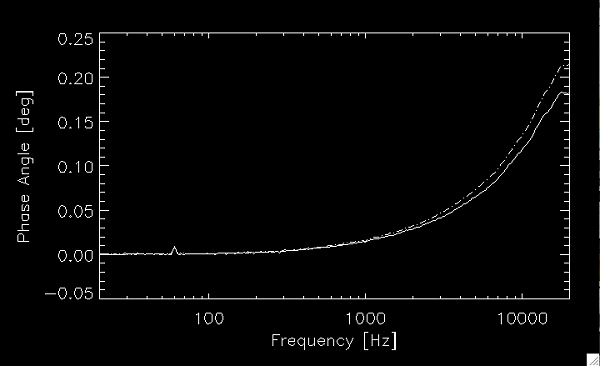
Here (graph above), we see a plot of the Silver Eclipse speaker cable’s phase angle as a function of frequency for both straight (solid) and coiled (dashed) geometries. The rise of the phase angle with frequency is a basic feature of almost any cable design driving such a low impedance load. The important thing to notice is the y-axis: the phase angle introduced by these cables is spectacularly low. Uncoiled, the maximum phase angle is 0.180, which rises to 0.220 when coiled. The small bump at 60 Hz is a measurement artifact from 60 Hz AC pickup. This result is a full order of magnitude (a factor of 10) less than my usual speaker cables measured the same way! In addition, the phase angle increases only a little when coiled. I did not plot the resistance, as it did not change much with frequency. The resistance added by these cables is also a spectacularly low 0.01 Ohms. This is also about a factor of 10 better than my normal cables. I really can’t imagine better measurement results.
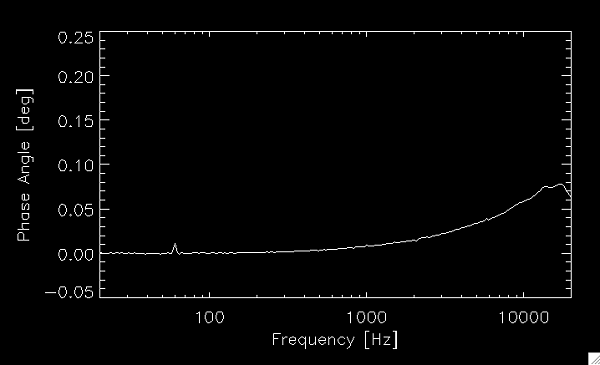
The interconnects show a similar story (graph above), but add even less phase angle to the load impedance. Maximum phase angle introduced is only 0.080. This is again about 10 times lower than my usual interconnect. The same small 60 Hz bump is there, again from the measurement setup. There was no significant difference between straight and coiled geometries, so I only plotted one line.
In addition to direct impedance measurements, I also measured the series inductance and shunt capacitance of the cables. I measured 300 nH series inductance and 3.3 nF of shunt capacitance at 15 kHz for the silver eclipse speaker cable. This works out to 30 nH/ft inductance and 330 pF/ft capacitance. The silver eclipse interconnect measured 135 nH series inductance (20 nH/ft) and 2.0 nF shunt capacitance (300 pF/ft). The characteristic impedance implied by these numbers is 9.5 ohms for the speaker cable and 8.2 ohms for the interconnect. This is fully consistent with the cable’s very low measured phase angle driving a 10 ohm load.
Conclusions
Yes, these cables are expensive. But they made a real improvement in the sound of my system, even when compared to the very good cables they replaced. They also showed 10 times lower reactance, and 10 times lower resistance than my usual cables. This combination of great sound and great measured performance earns them my highest recommendation. If your system is already fairly polished, these cables (or some of Wireworld’s more reasonably priced cables) could be the last little step towards audio nirvana.


